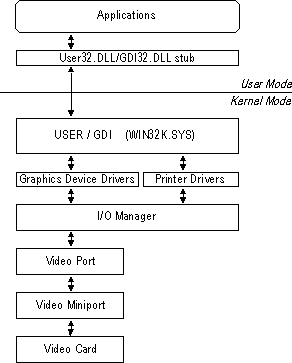
Graphics device drivers are dynamic link libraries of functions that let GDI communicate with graphic output hardware devices such as monitors, printers, and fax machines. Display drivers and printer drivers are the most common graphics device drivers. The following section describes display drivers in detail. For more information about printer drivers, see Chapter 7, "Printing."
Display drivers draw text and graphics on the display and retrieve information about the display device (such as color resolution, screen size and screen resolution). They are specific to a hardware device or group of devices and are sometimes provided by hardware vendors. Windows NT 4.0 Workstation and Server include graphics device drivers for most common devices.
Display drivers are higher-level drivers which reside between the Graphics Device Interface (GDI) and lower-level drivers which control the hardware. They receive application requests from GDI and call GDI functions to help fulfill requests, or break them down into simpler tasks that the hardware device can handle.

Display drivers depend on lower-level drivers. They are paired with video miniports, which are hardware-manipulating drivers provided by the display driver vendor.. Windows NT provides a video port and a library of common functions to simplify the tasks of the display driver and video miniport. It also ships with several display drivers and their miniports.
The miniport carries out user and application requests to configure the hardware for a specific video mode.. It also enables the graphics device drivers to communicate directly with the hardware. For example, when a miniport sets up registers and memory frame buffers for a hardware device, it also sends the display driver pointers to the buffers so that the GDI and the driver can write directly to the device's memory.
Prior to Windows NT 4.0, display drivers and printer drivers were part of the Win32 subsystem and ran in user mode. They are now part of the Windows NT Executive running in kernel mode. As a result, display drivers written for previous versions of Windows NT will not run on Windows NT 4.0, and new kernel-mode display drivers written for Windows NT 4.0 are not backward compatible. However, video miniports, which have always run in kernel mode, do not need to be revised to comply with the new architecture.